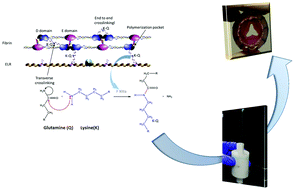Hybrid elastin-like recombinamer-fibrin gels: physical characterization and in vitro evaluation for cardiovascular tissue engineering applications†
Abstract
In the field of tissue engineering, the properties of the scaffolds are of crucial importance for the success of the application. Hybrid materials combine the properties of the different components that constitute them. In this study hybrid gels of Elastin-Like Recombinamer (ELR) and fibrin were prepared with a range of polymer concentrations and ELR-to-fibrin ratios. The correlation between SEM micrographs, porosities, swelling ratios and rheological properties was discussed and a poroelastic mechanism was suggested to explain the mechanical behavior of the hybrid gels. Applicability as scaffold materials for cardiovascular tissue engineering was shown by the realization of cell-laden matrixes which supported the synthesis of collagens as revealed by immunohistochemical analysis. As a proof of concept, a tissue-engineered heart valve was fabricated by injection moulding and cultivated in a bioreactor for 3 weeks under dynamic conditions. Tissue analysis revealed the production of collagen I and III, fundamental proteins for cardiovascular constructs.


 Please wait while we load your content...
Please wait while we load your content...